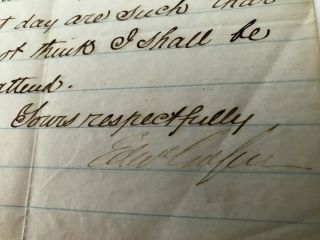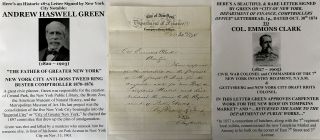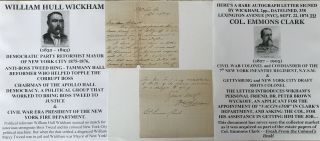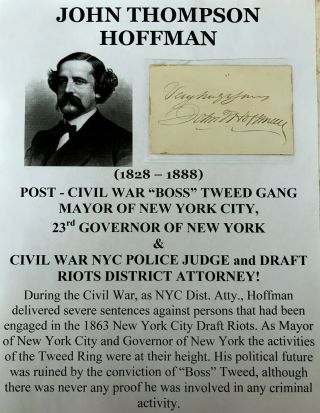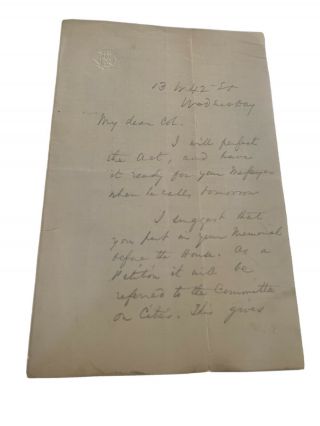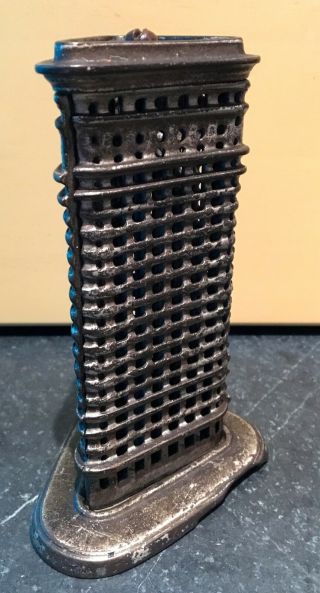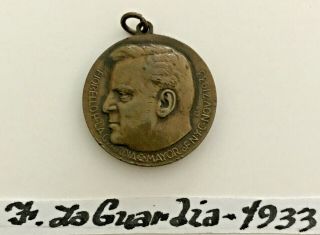IRON INDUSTRIALIST MAYOR YORK CITY BOSS TWEED RING BUSTER LETTER SIGNED 1880
Item History & Price
| Reference Number: Avaluer:1538146 | Modified Item: No |
| Country/Region of Manufacture: United States |
HERE’s A NEW YORK CITY DOCUMENT SIGNEDBY “BOSS TWEED” RING BUSTEREDWARD COOPER(1824 - 1905)83rdMAYOROF NEW YORK CITY1879-1880 -A DEMOCRAT, ONLYSURVIVING SON OF INDUSTRIALIST PETER COOPER&ACTIVEMEMBER OF THE “COMMITTEE OF SEVENTY, ”THROUGH WHOSE EFFORTS THE CORRUPT TWEED RING WAS OVERTHROWN.EdwardCooper's ironmaster business partner and brother-in-law, AbramS. Hewitt, also served as Mayor of New York City (1887–1888).Cooper was on the founding Board of Trustees of the Co...operUnion, and also served as President of the school from1883 to 1905.Here’s a RARE LETTER SIGNED BY COOPER, as Mayor of New York City on attractive, “Mayor’sOffice” Letterhead, dated at New York, Sept. 28th 1880 TOCOL. EMMONS CLARK(1827 – 1905)CIVIL WAR COLONEL and COMMANDER OF THE7th NEW YORK INFANTRY REGIMENT, N.Y.S.M.&GETTYSBURG and NEW YORK CITY DRAFTRIOTS COLONEL.In this letter Cooper declines aninvitation to visit the “new” 7thRegiment Armory in New York City, due to other engagements.NOTE: President Abraham Lincoln was delighted when he mustered into service the firstregiment for the Civil War - The New York Seventh Infantry Regiment. It should also be noted that the 7thRegiment Armory in Manhattan, New York City is on the National Register ofHistoric Places, and is a work of art! PROVENANCE:This autograph has never seen the collector market as itwas acquired as part of the estate papers of Col. Emmons Clark - - Fresh From the Colonel’s Desk!The document measures 5½”x 9” and is in VERY GOOD CONDITION.ARARE PIECE OF NEW YORK CITY POLITICAL HISTORY TO ADD TO YOUR AUTOGRAPH, MANUSCRIPT & EPHEMERA COLLECTION!BIOGRAPHICAL SKETCH OF THE HONORABLE EDWARD COOPERCooper, Edward(26 October 1824–25 February 1905), businessman, philanthropist, and politician, was born in New York City, the son of Peter Cooper, a businessman, philanthropist, and public figure, and Sarah Bedell. Afterattending public school in New York City, the younger Cooper enrolled atColumbia College, but he earned no degree. At Columbia College, Cooper met Abram S. Hewitt.The two men became fast friends, traveled together in Europe during 1844, thensurvived when the ship returning them to the United States foundered off theEast Coast that December. They were lifelong friends, business partners, and, when Hewitt married Cooper’s sister Amelia Cooper in 1855, brothers-in-law aswell.Cooper and Hewitt entered the iron business in 1845, building and thenmanaging a mill in Trenton, New Jersey. Their venture was largely made possibleby the capital of Peter Cooper, long a leading ironmaster, who had beenplanning to build in Trenton. Although opposed to partnerships (he neverentered one himself), Peter Cooper allowed his son and Hewitt to operate onthis basis. Peter Cooper served as president, Hewitt as manager, and EdwardCooper as supervisor of operations of the Trenton Iron Company. Like his father, Edward Cooper was interested in metallurgy and technology. Desiring the widestpublic benefit from his inventions, he declined to patent them. Within a fewyears, the young men formed a partnership, Cooper & Hewitt, sometimescalled Cooper, Hewitt, and Company, which became the agent for the Trentonmill. They subsequently expanded their business activities as the aging PeterCooper became less involved in such pursuits. Edward Cooper’s enterprisesearned him directorships in a range of business firms. Upon the death of hisfather in 1883, Edward Cooper succeeded to the presidency of the board ofCooper Union, an institute devoted to “the advancement of science and art intheir application to the varied and useful purposes of life, ” which the elder Cooperhad founded during the 1850s. Edward Cooper also was active in the affairs of anumber of New York City cultural institutions and clubs. In 1863 Cooper marriedCornelia Redmond; they had one child.Although elected to public office only once, Cooper made his politicalmark in New York City. A Democrat, he served as a delegate to his party’snational conventions of 1860 in Charleston, South Carolina, and 1876 in St.Louis. Cooper, Hewitt, Samuel J. Tilden, and others like them were termed Swallowtails (after the form of dress coatpreferred by the well to do), businessmen and professionals who sought toinfluence national and state politics and governmental policies and toperpetuate elite leadership of New York City politics and government againstprofessional politicians and their organizations, which were gaining strengthduring the 1850s through the 1870s. As a member of the prestigious reformCommittee of Seventy, Cooper participated in the overthrow of “Boss” William M. Tweedand his corrupt ring during 1871. Four years later Governor Tilden named Cooperto the blue-ribbon Commission to Devise a Plan for the Government of Cities inthe State of New York. In 1877 the commission reported a range of reformmeasures for incorporation in the state constitution, the most controversial ofwhich would create municipal boards of finance to pass on taxes, borrowing, spending, and two key city appointees. Voting for members of and membership on the boardsin cities of over 100, 000 population would be restricted to taxpayers onproperty assessed at more than $500 and rent payers of $250 or more per year.Cooper did not sign the report, for reasons that he did not explain, but helent his name to the effort, ultimately unsuccessful, to win ratification ofthe amendments.Following the toppling of the Tweed Ring, Cooper was among theSwallowtails who supported the reformed Tammany Hall, led by “Honest” John Kelly, but like many of the others he ultimately abandoned the organization as Kelly’sstar rose in Tammany and city government. Indeed, in 1878 Cooper, now an IrvingHall Democrat, won the mayoralty as a fusion candidate, supported by theRepublicans and the Independent Germans. He defeated Augustus Schell, thecandidate of Tammany Hall and a fellow Swallowtail. (Irving Hall, a Democraticfaction, provided Swallowtails with an organization to challenge Tammany Hall.)Cooper’s two-year mayoral term was defined by a conflict pitting Cooper andGovernor Lucius Robinson against Kelly. Control of the police board figuredprominently in the struggle, because the city’s politicized police departmentexerted considerable influence on elections. In the end, Kelly survived thechallenge, Robinson failed of reelection in 1879, and Cooper, although judged asuccessful mayor and considered as a mayoral nominee in 1886 and 1890, neveragain ran for office. Cooper was among those Swallowtails who, critical of bothTammany and Irving halls, founded the rival New York County Democracy in 1881.Cooper’s long prominence in business, philanthropy, and party and factionalpolitics placed him in the first rank of Democratic Swallowtails. Cooper diedin New York City.BibliographyCooper-Hewitt letterpress copybooks in the New-York Historical Society andthe Library of Congress include correspondence referring to politics, althoughbusiness affairs predominate. The New York Municipal Archives and RecordsCenter houses mayoral papers, but one must place primary reliance onnewspapers, biases and other shortcomings notwithstanding, in studying thepolitical involvement of Cooper. The New York Times, New YorkHerald, and New York Evening Express differed in perspective andare especially useful. Such was the closeness of the Hewitts and the Coopersthat Allan Nevins, Abram S. Hewitt: With Some Account of Peter Cooper(1935), provides the best introduction to Edward Cooper. On the politicalenvironment in which Cooper operated, see Iver Bernstein, The New York CityDraft Riots: Their Significance for American Society and Politics in the Age ofthe Civil War (1990), and David C. Hammack, Power and Society: GreaterNew York at the Turn of the Century (1982). A thorough obituary is in the NewYork Times, 26 Feb. 1905. [Source: American National Biography]I am a proud member of the Universal Autograph Collectors Club(UACC), The Ephemera Society of America, the Manuscript Society and theAmerican Political Items Collectors (APIC) (member name: John Lissandrello). Isubscribe to each organizations' code of ethics and authenticity is guaranteed.~Providing quality service and historical memorabilia online for over twentyyears.~
WE ONLY SELL GENUINE ITEMS, i.e., NO REPRODUCTIONS, FAKES OR COPIES!
WE ONLY SELL GENUINE ITEMS, i.e., NO REPRODUCTIONS, FAKES OR COPIES!




